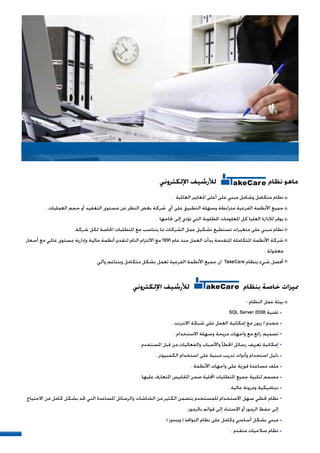???? ???? ??????? ?????????? | ??? ???
- 1. akeCare ??????????? ???????? ?????? ?????????? ??????? ??????? ??????? ????????? ???? ????????? ??????? ???????
- 2. ??????????? ???????? ?????? ??????akeCare . ????????? ????????? ?????? ????? ?????? ??????? ???????? ?????? . ?????????? ????? ???? ????????? ??????? ???? ??????? ????? ?????? ???? ????? ????????? ??????? ????????? ????????? ???????? ?????? . ??????? ????? ?????? ?????? ????????? ?????????? ???? ???????? ???????? ?????? .?????? ????? ??????? ?????????? ???? ???????? ???? ????????? ????? ??????? ???????? ????????? ????? ?????? ?????? ??????? ???? ?????? ??????? ????????? ??????? ??????? ??????? ??????? ????????? ???? 1991 ????? ????? ??????? ?????? ????????? ?????????? ???????? ?????? . ???????? .?????? ????????? ???????? ?????? ?????? ????????? ???????? ?????? ???? TakeCare ??????? ????? ?????? ??????????? ???????? ??????? ?????? ???????akeCare : ???????? ????? ?????? SQL Server 2008 ??????? . ????????? ?????? ????? ??????? ????????? ???? ?????? / ?????? . ?????????? ??????? ??????? ???????? ???? ?????? ??????? . ????????? ????? ???? ???????????? ????????? ?????? ??????? ??????? ????????? . ??????????? ????????? ????? ??????? ??????? ???????? ????????? ?????? . ???????? ???????? ????? ??????? ???????? ????? . ??????? ????????? ????????? ????? ??????? ?????????? ?????? ???????? ?????? . ??????? ???????? ??????????? ????????? ???? ?????? ?????? ???? ?????? ????????? ?????????? ????????? ???? ???????? ??????? ?????????? ?????????? ????? ????? ?????? . ????????? ??????? ????? ????????? ???? ???????? ????? ????? . ( ???????? ) ????????? ?????? ????? ??????? ??????? ?????? ?????? . ??????? ???????? ??????
- 3. ????????? ?????????? ???????? ?????? ??????? - ?????? : ??? . ??? : ?????? : ?????? : ??????????? ??????? : ??????????? ???????? www.atscgroup.com info@atscgroup.com9836 +963 11 3331150 +963 11 3323185 +963 11 3327184 . ??????????? ??????? ???????? ?????? ????? ?????? ????? ????? ????? ( ???????? - ???????? – ???????? – ?)????? . ????????? ??????? ????? ?????? ???????? ?????? ????? ?????? . ??????? ?????? ????? ???? ?????? ????? ???? ??????? ?????? ???????? ????? ????? ????? ??????? ???????? : ?????? ???? ????????? ??????? ????? . ???????? ??????? . ??????? ??????? ???? ????? ?????? . ??????????? ???????? ???? . ???????? ???? . ??????? ?6.??????? ??? ???????? ???????? ???????? ????????? ????? ????? ????? ????????? ????? ????????? ??????? ????? ????? ??????? ???? ????????? ???????? ????? ?????????????? ???????? ???? ??????? ???? ???? ????????? ??? ??????? ????? ???? ???? ?????? .??????????? ???????? ??????? ????? ???? ????? ????? ???? ????????? . ????? ???? ???? ???????? ???? ??????? ??????? . ??????.....???? ??????? – ????????? ??????? ?????? ????????? – ??????? ?????????? ???? ???????? ??????? ???? ???? ???????? ???????? . ?????????? ??? ????????? ????????? ??????? ???? ???? ???????? . ?????? ????????? ?????? ?57???? ???? ???????? ??????? ????? ??????? ??? ??????? ??????? ?????? ???????? ????? . ??????????? ???????? ????? ???????? ?????? ??????? ??????? ??? ????????? ??? ???????? ??????? ?????? . ???????? ?????? ???? ????? ?????????? ????? ???????? ????? ????? ??????? ?????? ?????? ?????? . ?????????? ?????? ???? ?????? ???????? ??????? ????? ???? ?????? ???? ????? ????? ???? ?????? ??????? ???? ????? ?????? . ??????? ???? ???? ????????? ?????????? ?????? ?????? ?????? ????? ???????? ????? ?????? ???????? ??????? ????? ) ????????? ??????? ????? ????????? ??????? ????????? ???????? ?????? ???? ?????? ?????? ????????? ????? ?????? ( ???????? ???????? .??????????? ????????? ?????? ???? ???????? ?????? ????????? ?????? ????? ?????? ??? ????????? ?????? ???? ????? ???? ????? ?????? . ???????? ???????? ????? ??????? ???? ??????? ?????? . ???????? ??????????? ???????? ????? ??????? ???? ??????? ?????? . ?????? ?57???? ????? ??????? ??????? ?????? . (?...???? - ?????? – ?)??????????????? ????? ????? ???? ??????? ????? ?????? ????????? ???? ????????? ?????? ??????????? ???????? ??????



